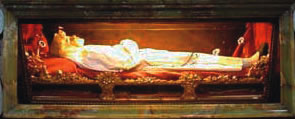May Saints
 Blessed Ceferino Gimenez Malla (1861-1936)
Blessed Ceferino Gimenez Malla (1861-1936)
Ceferino Gimenez Malla (El Pelé) was born in Spain in 1861. He was illiterate and spent his first 20 years on the road. When he was almost 20 he married Teresa Jimenez Castro in a gypsy ceremony. The couple had no children, so they adopted Teresa’s niece, Pepita, and brought her up as a devout Catholic.
El Pelé was a true gypsy, following the diet and language of his forefathers. Like all his people, he was a colourful character, strong-minded and strong-willed, but able to empathise with those worse off than himself.
In January 1912, after 30 years of gypsy marriage, Ceferino and Teresa celebrated a religious wedding, and received Holy Communion during the ceremony. A daily communicant, he went to all the processions, accompanied the priest carrying Viaticum to the sick, and said the rosary with the old people. He gathered the children to teach them the Bible, prayers and hymns and went with them to church.
When he was passing by, people would say, “Stop swearing! El Pelé is coming!” He was strict with himself, generous with others. Anonymously, he gave money to the needy. When his wife died in 1922, he sold his own house and rented another home. In 1926 he joined the Third Order of St Francis. Like his patron, he carried within himself brotherhood, peace and joy.
At the beginning of the Civil War in Spain in 1936, El Pelé was 75 years old. He had a strong personality and was unafraid of people’s opinions. When he protested the arrest of a young priest by the Spanish revolutionary militia, he was caught, searched and arrested. He had in his pocket a penknife and his rosary. He was offered his freedom if he stopped saying the rosary. He refused, so he was singled out for punishment.
He was shot on August 2, 1936, in the cemetery of Barbastro. Colourful to the end, he died with his rosary in his hands, crying, “Long live Christ the King!”
Blessed Ceferino, give us a deep devotion to the Rosary.
(Source: Internet – various)
 Blessed Imelda (d. 1333)
Blessed Imelda (d. 1333)
The patroness of fervent first communion, Blessed Imelda, came from an old family in Bologna. Even as a tiny child she showed unusual piety, taking delight in prayer and slipping off to a quiet corner of the house, which she adorned with flowers and pictures to make it a little oratory. At age nine, she went to the Dominican convent in Val di Pietra, to be trained by the nuns. Her special devotion was to the Eucharistic presence of Our Lord. To receive Holy Communion became the consuming desire of her heart, but the earliest age for a first communion was twelve.
When she was only eleven, she was present with the rest of the community at the Ascension Day Mass. All the others had received their communion: only Imelda was left unsatisfied. The nuns were preparing to leave the church when some of them were startled to see what appeared to be a Sacred Host hovering in the air above Imelda, as she knelt before the closed tabernacle absorbed in prayer. Quickly they attracted the attention of the priest. In the face of such a miracle he could not do otherwise than give to Imelda her first communion, which was also her last. The rapture with which she received her Lord was so great that it broke her heart: she sank unconscious to the ground, and when loving hands upraised her, it was found she was dead.
Blessed Imelda, teach us to love the Eucharist.
(Source: http://www.catholic.org/saints/saint.php?saint_id=125)
 Saint Bernadine of Siena
Saint Bernadine of Siena
(1380-1444)
Born in Siena of a noble family, Saint Bernadine was a great preacher throughout Italy and a restorer of strict observance in the Franciscan order, especially in the matter of poverty. His vernacular sermons were written down and are as fresh and lively and applicable today as when they were first spoken; his amusing pictures of such familiar things as a bachelor household, women’s fashions, men’s exactingness, “pious” superstitions etc have a bite in them – not for nothing was he called “The people’s preacher.” With Saint John of Capistrano he spread devotion to the Holy Name, displaying the monogram IHS for veneration and having it painted on houses.
Saint Bernadine, instil in us a deep reverence for the Holy Name of Jesus.
(Source: A New Dictionary of the Saints, Donald Attwater. 1993 Burns & Oates, Kent)
 Entries(RSS)
Entries(RSS)